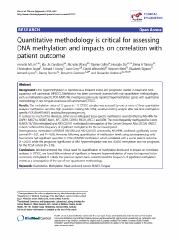Please use this identifier to cite or link to this item:
https://ahro.austin.org.au/austinjspui/handle/1/12729| Title: | Quantitative methodology is critical for assessing DNA methylation and impacts on correlation with patient outcome. | Austin Authors: | Lim, Annette M;Candiloro, Ida Lm;Wong, Nicholas;Collins, Marnie;Do, Hongdo;Takano, Elena A;Angel, Christopher;Young, Richard J;Corry, June;Wiesenfeld, David;Kleid, Stephen;Sigston, Elizabeth;Lyons, Bernard;Rischin, Danny;Solomon, Benjamin J;Dobrovic, Alexander | Affiliation: | Translational Genomics and Epigenomics Laboratory, Ludwig Institute for Cancer Research, Olivia Newton-John Cancer & Wellness Centre, Austin Health, 145-163 Studley Road, Heidelberg, Victoria 3084 Australia ; Department of Pathology, Peter MacCallum Cancer Centre, Locked Bag 1 A'Beckett Street, Melbourne, Victoria 8006 Australia ; School of Cancer Medicine, La Trobe University, Bundoora, Victoria 3084 Australia The University of Melbourne, Parkville, Victoria 3010 Australia ; Translational Genomics and Epigenomics Laboratory, Ludwig Institute for Cancer Research, Olivia Newton-John Cancer & Wellness Centre, Austin Health, 145-163 Studley Road, Heidelberg, Victoria 3084 Australia Department of Surgery, Monash Medical Centre, 246 Clayton Road, Clayton, Victoria 3168 Australia Department of Surgical Oncology, Peter MacCallum Cancer Centre, Locked Bag 1 A'Beckett Street, Melbourne, Victoria 8006 Australia Department of Surgery, Royal Melbourne Hospital, 300 Grattan St, Parkville, Victoria 3050 Australia The University of Melbourne, Parkville, Victoria 3010 Australia ; Department of Radiation Oncology, Peter MacCallum Cancer Centre, Locked Bag 1 A'Beckett Street, Melbourne, Victoria 8006 Australia Research Division, Peter MacCallum Cancer Centre, Locked Bag 1 A'Beckett Street, Melbourne, Victoria 8006 Australia Department of Pathology, Peter MacCallum Cancer Centre, Locked Bag 1 A'Beckett Street, Melbourne, Victoria 8006 Australia Research Division, Peter MacCallum Cancer Centre, Locked Bag 1 A'Beckett Street, Melbourne, Victoria 8006 Australia ; Department of Pathology, Peter MacCallum Cancer Centre, Locked Bag 1 A'Beckett Street, Melbourne, Victoria 8006 Australia Department of Biostatistics and Clinical Trials, Peter MacCallum Cancer Centre, Locked Bag 1 A'Beckett Street, Melbourne, Victoria 8006 Australia Research Division, Peter MacCallum Cancer Centre, Locked Bag 1 A'Beckett Street, Melbourne, Victoria 8006 Australia ; Department of Microbiology and Immunology, The University of Melbourne, at the Peter Doherty Institute for Infection and Immunity, Melbourne, Victoria 3010 Australia Department of Medical Oncology, Peter MacCallum Cancer Centre, Locked Bag 1 A'Beckett Street, Melbourne, Victoria 8006 Australia ; The University of Melbourne, Parkville, Victoria 3010 Australia ; Research Division, Peter MacCallum Cancer Centre, Locked Bag 1 A'Beckett Street, Melbourne, Victoria 8006 Australia Department of Medical Oncology, Peter MacCallum Cancer Centre, Locked Bag 1 A'Beckett Street, Melbourne, Victoria 8006 Australia ; The University of Melbourne, Parkville, Victoria 3010 Australia Translational Genomics and Epigenomics Laboratory, Ludwig Institute for Cancer Research, Olivia Newton-John Cancer & Wellness Centre, Austin Health, 145-163 Studley Road, Heidelberg, Victoria 3084 Australia ; Department of Pathology, Peter MacCallum Cancer Centre, Locked Bag 1 A'Beckett Street, Melbourne, Victoria 8006 Australia ; Department of Pathology, The University of Melbourne, Parkville, Victoria 3010 Australia ; School of Cancer Medicine, La Trobe University, Bundoora, Victoria 3084 Australia Department of Surgery, St Vincent's Hospital, PO Box 2900, Fitzroy, Victoria 3065 Australia |
Issue Date: | 9-Dec-2014 | Publication information: | Clinical Epigenetics 2014; 6(1): 22 | Abstract: | DNA hypermethylation is reported as a frequent event and prognostic marker in head and neck squamous cell carcinomas (HNSCC). Methylation has been commonly assessed with non-quantitative methodologies, such as methylation-specific PCR (MSP). We investigated previously reported hypermethylated genes with quantitative methodology in oral tongue squamous cell carcinomas (OTSCC).The methylation status of 12 genes in 115 OTSCC samples was assessed by one or more of three quantitative analyses: methylation sensitive high resolution melting (MS-HRM), sensitive-melting analysis after real time-methylation specific PCR (SMART-MSP), and bisulfite pyrosequencing. In contrast to much of the literature, either no or infrequent locus-specific methylation was identified by MS-HRM for DAPK1, RASSF1A, MGMT, MLH1, APC, CDH1, CDH13, BRCA1, ERCC1, and ATM. The most frequently methylated loci were RUNX3 (18/108 methylated) and ABO (22/107 methylated). Interrogation of the Cancer Genome Atlas (TCGA) HNSCC cohort confirmed the frequency of significant methylation for the loci investigated. Heterogeneous methylation of RUNX3 (18/108) and ABO (22/107) detected by MS-HRM, conferred significantly worse survival (P = 0.01, and P = 0.03). However, following quantification of methylation levels using pyrosequencing, only four tumors had significant quantities (>15%) of RUNX3 methylation which correlated with a worse patient outcome (P <0.001), while the prognostic significance of ABO hypermethylation was lost. RUNX3 methylation was not prognostic for the TCGA cohort (P = 0.76).We demonstrated the critical need for quantification of methylation levels and its impact on correlative analyses. In OTSCC, we found little evidence of significant or frequent hypermethylation of many loci reported to be commonly methylated. It is likely that previous reports have overestimated the frequency of significant methylation events as a consequence of the use of non-quantitative methodology. | Gov't Doc #: | 25859283 | URI: | https://ahro.austin.org.au/austinjspui/handle/1/12729 | DOI: | 10.1186/1868-7083-6-22 | Journal: | Clinical epigenetics | URL: | https://pubmed.ncbi.nlm.nih.gov/25859283 | Type: | Journal Article | Subjects: | Head and neck cancer Methylation Quantitative RUNX3 Tongue |
| Appears in Collections: | Journal articles |
Files in This Item:
| File | Description | Size | Format | |
|---|---|---|---|---|
| 25859283.pdf | 810.84 kB | Adobe PDF |  View/Open |
Page view(s)
18
checked on Nov 19, 2024
Download(s)
108
checked on Nov 19, 2024
Google ScholarTM
Check
Items in AHRO are protected by copyright, with all rights reserved, unless otherwise indicated.
